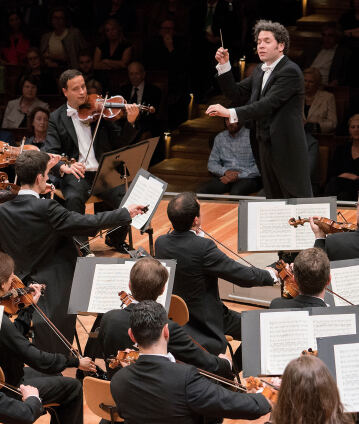Gustavo Dudamel conducts Dvořák’s Symphony “From the New World”

Antonín Dvořák’s Ninth Symphony, composed in New York, presents itself as colourful, yearning, with a somewhat exotic touch – an inspired fusion of American impressions and symphonic music. In an exciting juxtaposition, Gustavo Dudamel also conducts John Adams’s City Noir. Here too there is a fascinating mixture of styles, this time between classical music and jazz of the 1940s and 1950s.
The very title of John Adams’s three-movement orchestral work City Noir indicates that the piece was inspired by film noir: the idea for the piece came to the composer by “reading Kevin Starr’s multi-volume cultural and social history of California. In the ‘Black Dahlia’ chapter of his Embattled Dreams: California in War and Peace, 1940–1950 Starr chronicles the tenor and milieu of the late Forties and early Fifties as it was expressed in the sensational journalism of the era and in the dark, eerie chiaroscuro of the Hollywood films. This whetted my appetite for an orchestral work that, while not necessarily referring to the soundtracks of those films, might nevertheless evoke a similar mood and feeling, the tone of the era.”
City Noir at its outset, with little in common with Adams’s minimalist works from the 1980s and 1990s, gives rise to a number of musical associations, ranging from Stravinsky to Gershwin, Bernstein and Milhaud to John Coltrane, before nervous jazz rhythms and recurrent patterns truly transport the listener back to America of that time – at the latest in the central middle movement, with its typically American mixture of classical and jazz style, in which the music, Adams says, “yearns toward but keeps retreating from the archetypal ‘blue’ note. But eventually the song finds full bloom in the voice of the solo trombone, a ‘talking’ solo, in the manner of the great Ellington soloists Lawrence Brown and Britt Woodman (both, fittingly enough, Angelenos).”
Gustavo Dudamel, who premiered Adams’s homage to the great age of bebop to great acclaim at his inaugural concert as Music Director of the Los Angeles Philharmonic Orchestra, is now turning to the work with the Berliner Philharmoniker, with whom he had the “coolest” debut of all time in 2008, according to the Tagesspiegel. The programme continues with Antonín Dvořák’s symphony From the New World – a work in which the composer as director of the New York National Conservatory of Music avowedly attempted with the help of stylised musical folklore “to portray characteristics such as are distinctly American”. Obviously successfully, because after the triumphant premiere the critics of all the New York newspapers agreed: they had heard “a study in national music” (New York Times). No one these days should doubt, however, that Dvořák’s masterpiece is deeply rooted in the Bohemian musical tradition.
© 2017 Berlin Phil Media GmbH
Related interviews
Artists
Our recommendations
- An “American Evening” with Gustavo Dudamel
- With Gustavo Dudamel in Taiwan
- A “Russian Evening” with Gustavo Dudamel and Viktoria Mullova
- Gustavo Dudamel conducts Mahler’s Fifth Symphony
- Europakonzert 2012 from Vienna with Gustavo Dudamel and Gautier Capuçon
- Gustavo Dudamel conducts Shostakovich’s Symphony No. 12